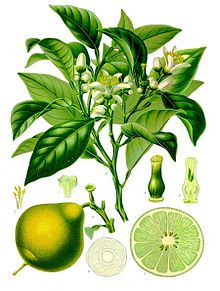
Citrus bergamia

Citrus bergamia, the bergamot orange (pronounced /ˈbɜːrɡəˌmɒt/), is a fragrant citrus fruit the size of an orange, with a yellow or green color similar to a lime, depending on ripeness. Genetic research into the ancestral origins of extant citrus cultivars found bergamot orange to be a probable hybrid of lemon and bitter orange. Extracts have been used to scent food, perfumes, and cosmetics. Use on the skin can increase photosensitivity, resulting in greater damage from sun exposure. The word bergamot is etymologically derived from the Italian word 'bergamotto', ultimately of Turkish origin: bey armudu or bey armut ('prince's pear' or 'prince of pears'). Citrus bergamia is a small tree that blossoms during the winter. The juice tastes less sour than lemon, but more bitter than grapefruit. The active ingredients in bergamot juice are neoeriocitrin, naringin, neohesperidin, ponceritin, melitidin, and mitrocin and 0.69% miriflin with 0% moisture brutieridin. Melitidin and brutieridin exhibit statin-like properties. Synephrine is not present in citrus bergamot. The bergamot orange is unrelated to the herbs known as bergamot or wild bergamot, Monarda didyma and Monarda fistulosa, which are in the mint family, and are named for their similar aroma. Citrus bergamia has also been classified as Citrus aurantium subsp. bergamia (i.e. a subspecies of bitter orange). Citrus bergamia is sometimes confused with (but is not the same as):
